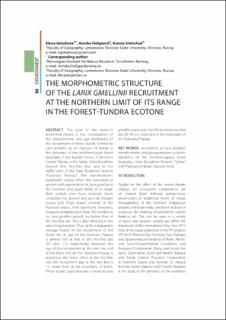The Morphometric structure of the Larix Gmellinii recruitment at the northern limit of its range in the forest-tundra ecotone
Peer reviewed
Published version

View/
Date
2013Metadata
Show full item recordCollections
- Scientific publications [1345]
Original version
10.15356/2071-9388_03v06_2013_06Abstract
The goal of the research presented herein is the investigation of the morphometric and age parameters of the recruitment of forest stands formed by Larix gmellinii, as an indicator of trends in the dynamics of the northern/upper forest boundary in the Russian Arctic, in Northern Central Siberia, in the Taimyr State Biosphere Reserve (the Ary-Mas site), and in the buffer zone of the State Biosphere Reserve “Putorana Plateau”. The morphometric parameters clearly reflect the conditions of growth and regeneration of Larix gmellinii at the northern and upper limits of its range. Both sample sites have relatively harsh conditions for growth and survival. Despite coarse soils (high gravel content) of the Putorana slopes, their significant steepness, frequent landslides and creep, the conditions for Larix gmellinii growth are better than at the Ary-Mas site. This is also reflected in the rate of regeneration. Thus, at the comparable average height of the recruitment at the forest line, its age on the Putorana Plateau is almost half of that at the Ary-Mas site (9.7 and 17.3, respectively). However, the age of the recruitment at the tree line and at the forest line on the Putorana Plateau is practically the same, while at the Ary-Mas site, the recruitment age at the tree line is 1.5 lower than at the boundary of forest. These results could indicate a trend of Larix gmellinii expansion into the ecotone over the last 20–30 yrs., especially in the mountains of the Putorana Plateau
